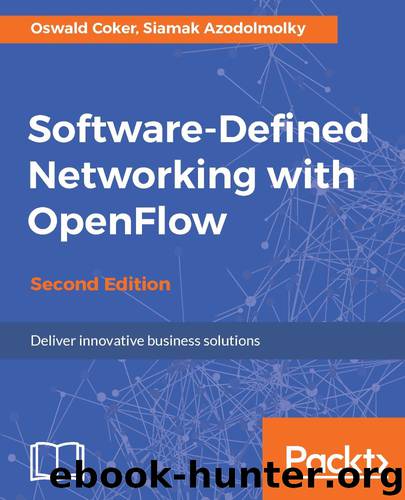Software-Defined Networking with OpenFlow - Second Edition: Deliver innovative business solutions by Oswald Coker & Siamak Azodolmolky

Author:Oswald Coker & Siamak Azodolmolky [Coker, Oswald]
Language: eng
Format: azw3
Tags: COM043040 - COMPUTERS / Networking / Network Protocols, COM051000 - COMPUTERS / Programming / General, COM043000 - COMPUTERS / Networking / General
Publisher: Packt Publishing
Published: 2017-10-25T04:00:00+00:00
External controllers
When you start a Mininet network, each switch can be connected to a remote controller, which could be in the Mininet VM, outside the Mininet VM, and on your local machine, or in principle anywhere in the internet. This setup may be convenient if you already have a controller framework and development tool installed on the localhost or you want to test a controller running on a different physical machine. If you want to try this, you have to make sure that your controller is reachable from the Mininet VM and fill in the host IP and/or listening port:
$ sudo mn --controller=remote,ip=[controller IP],port=[controller
listening port]
For instance, to run POX's sample learning switch, you could do something like this in one window:
$ cd ~/pox $ ./pox.py forwarding.l2_learning
In another window, start up Mininet to connect to the remote controller (which is actually running locally, but outside of Mininet's control):
$ sudo mn --controller=remote,ip=127.0.0.1,port=6633
Note that these are actually the default IP address and port values. If you generate some traffic (mininet> h1 ping h2) you should be able to observe some output in the POX window showing that the switch has connected and that some flow table entries have been installed.
Download
This site does not store any files on its server. We only index and link to content provided by other sites. Please contact the content providers to delete copyright contents if any and email us, we'll remove relevant links or contents immediately.
Deep Learning with Python by François Chollet(12953)
A Developer's Guide to Building Resilient Cloud Applications with Azure by Hamida Rebai Trabelsi(10327)
Hello! Python by Anthony Briggs(10193)
The Mikado Method by Ola Ellnestam Daniel Brolund(10101)
OCA Java SE 8 Programmer I Certification Guide by Mala Gupta(10039)
Dependency Injection in .NET by Mark Seemann(9580)
Hit Refresh by Satya Nadella(9013)
Algorithms of the Intelligent Web by Haralambos Marmanis;Dmitry Babenko(8584)
The Kubernetes Operator Framework Book by Michael Dame(8346)
Exploring Deepfakes by Bryan Lyon and Matt Tora(8146)
Robo-Advisor with Python by Aki Ranin(8094)
Practical Computer Architecture with Python and ARM by Alan Clements(8080)
Implementing Enterprise Observability for Success by Manisha Agrawal and Karun Krishnannair(8056)
Sass and Compass in Action by Wynn Netherland Nathan Weizenbaum Chris Eppstein Brandon Mathis(7964)
Svelte with Test-Driven Development by Daniel Irvine(7951)
Building Low Latency Applications with C++ by Sourav Ghosh(7946)
Grails in Action by Glen Smith Peter Ledbrook(7940)
Test-Driven iOS Development with Swift 4 by Dominik Hauser(7896)
Becoming a Dynamics 365 Finance and Supply Chain Solution Architect by Brent Dawson(7871)
